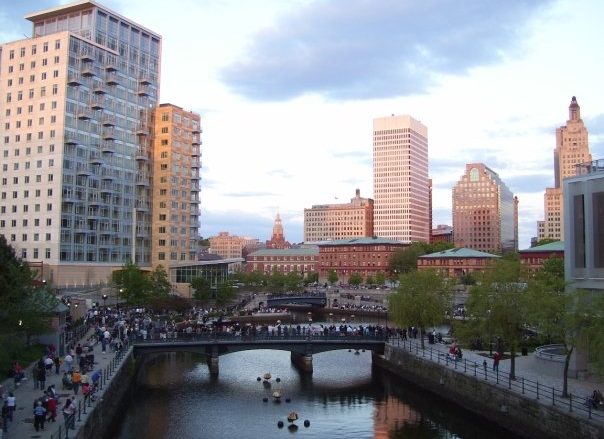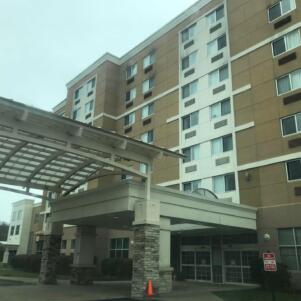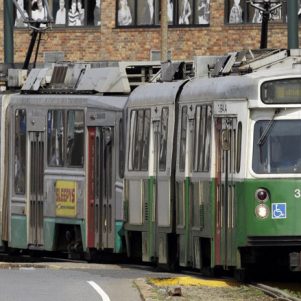Providence On the Brink?
By Stephen Beale | January 8, 2017, 8:16 EST

A combination of dwindling revenues and soaring costs has put Rhode Island’s capital city of Providence in such dire financial straits that some local businessmen think bankruptcy is the only way out.
Tax-exempt exempt hospitals and colleges — particularly Brown University — have cut deeply into the city’s tax base. State aid has declined. And the costs of road maintenance and educating more children with special needs continue to rise.
If Providence does nothing, it will face a $10 million deficit in 2019 — a gap equivalent to the salaries and benefits of almost a fourth of the city police force or a 4 percent property tax rate. By 2026, that deficit would balloon to $37 million, according to a report by the National Resource Network issued last year.
Perhaps looming largest are the unfunded pension liabilities for police officers, firemen, and other city workers, which total nearly $2 billion.
“I don’t know how you pay it,” said Ken Block, a local businessman and former GOP candidate for governor.
Last month, Block co-wrote an op-ed in the Providence Journal with Alan Hassenfeld, the former chairman and chief executive officer of toy manufacturer Hasbro, calling for bankruptcy.
Block said the pension debts are hampering the economic recovery of the city. He points to acres of supposedly prime real estate in the middle of Providence that has been vacant for years after the relocation of Interstate 195. Although a new proposal for residential development has been aired, no deal has yet to be inked or ground broken. The potentially high taxes that will be needed to deal with the city’s pension obligations are deterring developers, according to Block.
“What business owner wants to move there and, by default, own a piece of that?” Block said.
The most prominent monument to the city’s sluggish economic recovery is its iconic Superman Building, which has sat vacant in the heart of the downtown for about three years, after Bank of America moved out.
Providence already has one of the highest commercial property tax rates in the country.
Providence ranked fourth highest out of 53 mid- to large-size cities, according to a 2015 survey by the Lincoln Institute of Land Policy and the Minnesota Center for Fiscal Excellence. For the fiscal year that ended on June 30, 2015, the rate was $36.75 per $1,000 in property value. That means that a business with a property value of $1 million would pay $36,750 in taxes.
Block says the soaring pension costs are the result of bad deals made years ago by irresponsible politicians and union leaders. Particularly egregious are the high cost of living adjustments, or COLAs, that once were as much as 6 percent.
As of 2015, the most recently available year in state data, Providence had a pension debt of $951.8 million and the system was just 27.1 percent funded — not too much better than the 21.7 percent funding level in Central Falls, the state’s smallest city, which did go bankrupt in 2011. (Technically, the city ended up under a state-supervised receiver.)
When retiree health benefits are added in, the unfunded liability swells to $1.9 billion.
As a comparison, Detroit owed a total of $9.2 billion in unfunded retiree pay and health benefits when it went bankrupt in 2013, according to Block and Hassenfeld. But on a per capita basis, the debt loads are closer. Detroit, with a population of a little over 700,000, owed $12,934 per resident. Because Providence’s population is a fourth of Detroit’s, its per-person pension debt is an estimated $10,669.
The problem is compounded by the fact that Providence’s figures probably understate the enormity of its pension debts. That’s because the city has an assumed rate of return of 8 percent on the pension funds it invests — a rate that Block says is unrealistic in the current economic climate.
For every half a percentage point that the assumed return goes down, the unfunded retirement obligations shoots up by another $100 million. That means that the unfunded liability may be $300 million higher than publicized using an assumed rate of return of 6.5 percent that Block says is more realistic.
Soon after Block and Hassenfeld’s proposal for bankruptcy went public, WPRI-TV reported that Providence’s new mayor, Jorge Elorza, had spoken with his counterpart in Detroit. Elorza concluded that bankruptcy was not for Providence.
“Bankruptcy is not an option,” Elorza told WPRI. “And the reason for that is bankruptcy is not a solution.”
There is also an important intangible factor to consider: the bad press that might result from having the state’s largest city go financially belly up.
But one former top state official says that’s not always the case. “If it’s planned well and done well, it doesn’t have to be negative,” said Gary Sasse, the former director of administration and revenue under Governor Don Carcieri, a Republican.
Providence has been on the brink before. In 2011 newly elected mayor Angel Taveras said the city was facing the fiscal equivalent of a “Category 5 hurricane” after a probe revealed that it faced a deficit of $110 million — a huge shortfall in what then was an annual budget of about $600 million. (Taveras did not seek re-election in 2014, instead mounting an unsuccessful bid for governor as a Democratic candidate. Elorza is his successor.)
For a time, it seemed as though the city had been able to weather the storm — through a combination of concessions from all three city labor unions, a slew of miscellaneous budget cuts, a tax hike, and contributions from the colleges in the city that are normally exempt from taxes.
But then the city again found itself on the ropes in 2012, when some of the anticipated savings did not materialize. The year ended with the city again narrowly avoiding running out of cash.
The city’s finances have remained on shaky footing since then, plagued by recurring reports of strained finances.
Taveras did also tackle the city’s spiraling pension costs. His reform ended retiree cost of living adjustments that had been as high as 6 percent, shifted retirees over to Medicare, and altered how benefits are calculated.
And yet, by many measures, the pension system is still worse today than it was in 2010, the year before Taveras came into office. That year, the pension system — excluding health benefits — was 34.1 percent funded with an unfunded liability of $828.4 million. Today, that unfunded liability has grown by more than $100 million while the funding ratio has sunk below 30 percent. (The latest audit pegs it at 25 percent, according to a report on WPRI-TV.)
This is dangerously below what is generally considered a healthy level of funding by credit ratings agencies. For example, Fitch Ratings sets a 70 percent level as adequate whereas Standard & Poor’s eyes 80 percent as the average level, according to a report from the National Association of Retirement Administrators.
One local union leader says critics are being too hasty in dumping on pension reform, which was projected to take several decades to fix the system. “It’s a 30-year plan,” said Paul Doughty, president of the city firefighters union. “It’s going to take 30 years go do.”
As the city grapples with financial instability, Doughty says the last place it should come looking for additional concessions are its unions — especially after the National Resource Network report identified other areas of the budget that could be cut. “Don’t come looking to the public employees looking to solve the pension problem until you’re put some of your own skin in the game,” he said.
Block says higher taxes are inevitable in Providence. But he says bankruptcy would help mitigate the impact on residences and businesses.
Others are skeptical.
“It is not a panacea,” said Luis Aponte, the president of the Providence City Council.
Aponte said bankruptcy addresses just the costs the city is facing.
“But that is only half the picture,” he said.
The other half: the city’s revenues, which are diminutive relative to the value of property. About half of the properties in Providence are being taxed to fund basic services for all. The other half — about 40 percent — is tax exempt. That includes nonprofit colleges and universities, hospitals, and state and federally-owned lands and buildings.
“Bankruptcy does nothing to address that,” Aponte said.
Taveras did score deals to boost payments in lieu of taxes from city colleges. For example, as a result of that agreement, Brown paid $3.9 million to the city in 2014 — that was on top of other payments it had already agreed to make. The total amount the university paid to Providence was $8 million that year, according to data from Brown.
Still it’s not enough, according to Aponte. “They’re nowhere near close,” he said.
Brown has 158 properties that were tax-exempt, with a total value of $1 billion as of 2015, according to a city report. Were those properties to be taxed at the full commercial rate, Brown would owe the city $36.7 million.
Aponte has also been critical of tax break giveaways the city has made in the past to attract developers. Between 2013 and 2014, such deals drained another $15 million from city coffers.
Aponte says the tax base is shrinking, loading an ever larger burden on dwindling numbers of taxpayers. Getting tax-exempt landowners to pay closer to their fair share, he says, would enable the city to finally address its commercial tax rate.
Aponte has in mind more than just another one-time deal with nonprofits. Instead, he says the city should come up with a regular system of payments that would be predictable and permanent.
That approach, he says, would be preferable to having each new mayor attempt to rehash the deals with colleges and universities. (The past two mayors have each negotiated their own agreements and the current mayor has signaled that he might do the same.) Such predictability is better for both the city and the nonprofits, Aponte says.
Block, in turn, says Aponte’s plan sends a chilling message to business owners: that once in the city they are at risk for higher taxes.
But Aponte’s proposal has backing in the city. “It’s an eroding tax base that is controlled by an agreement that is politically driven rather than pragmatically driven,” Doughty said. “That’s a hard way to run a business, city, or any endeavor.”
“I think he makes a fair case that the city should be more aggressive in negotiating with tax-exempts,” said Sasse, who served as fiscal adviser to the city council in 2011. But he also sounds a cautionary note on the idea: “It will help, but it won’t solve the problem.”
In legal terms, Providence has a long ways to go before it can go bankrupt.
Under a state law passed after the city of Central Falls sought bankruptcy in 2010, there are three steps it must go first go through — and all three involve the cooperation of the state. First, the state would have to appoint a financial overseer. If that fails to work, a budget commission would take over city finances. Next, the state would tap a receiver to run the city. It would be the decision of the receiver to take the city into bankruptcy.
“Before we talk about municipal bankruptcy in Providence, the ball’s in the state’s court,” said Sasse.
Two cash-strapped Rhode Island communities have made it to the second step — East Providence and Woonsocket.
“Right now, it’s a shell game. How long can we delay the inevitable?” Block said.










